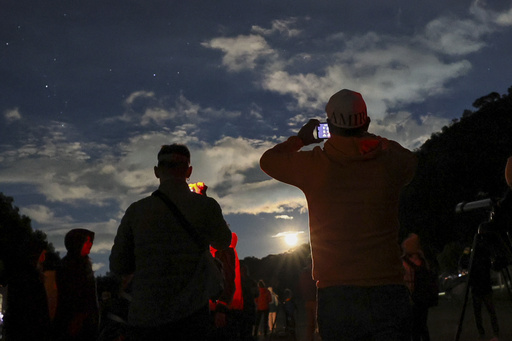
Juan Carlos Hernández adjusted a large telescope with precision, shouting to his companion, “Aim for me, Rich!” Ricardo Soriano then directed a laser pointer toward a patch of cloud, pinpointing the location where the Tsuchinshan-Atlas comet would soon become visible.
Last year, Hernández, along with fellow amateur astronomers, successfully achieved the designation of Joya-La Barreta Ecological Park as the first urban night sky space in Latin America, recognized by DarkSky International, an organization dedicated to educating the public about the dangers of excessive artificial lighting.
Situated at an elevation of about 8,520 feet (2,600 meters) outside Queretaro, the park offers a clear view of the night sky. While there are over 200 dark sky locations worldwide, Joya-La Barreta stands out as one of only 11 that are categorized as urban. Nonetheless, its classification is under constant jeopardy due to the rising issues of light pollution and urban encroachment.
For more than two decades, the 40-year-old Hernández has been a passionate advocate for the preservation of starry skies. He serves as the president of the Queretaro Astronomical Society and is a co-founder of Astronite, a stargazing tourism agency. Working as an aerospace engineer by day, he continues to seek out dark places for stargazing.
“In 2014, Omega Centauri was clearly visible right above the city,” he reminisced about the star cluster located over 17,000 light-years away. “Now, it’s almost impossible to see.”
A 2023 study analyzing data from over 50,000 stargazers indicated that artificial lighting is brightening the world’s night skies by approximately 10% annually. As of 2016, it was estimated that more than 80% of the global population lived beneath light-polluted skies.
In Mexico, research demonstrates that increased urban growth and the necessity for safety lighting are contributing significantly to light contamination.
According to Fernando Ávila Castro from the Institute of Astronomy at the National Autonomous University of Mexico, a fitting comparison for light pollution could be noise pollution. He explained, “Just like street noise can become distracting and disturbing, light pollution also affects life. All living organisms possess a circadian rhythm governed by external light conditions.”
“When night falls, we often forget there’s an entire ecosystem still at work,” Castro added.
Natural light from the moon and stars is essential for nocturnal activities for various plant and animal species, influencing when animals forage for food, when plants undergo reproduction cycles, and when certain animals embark on migrations. Since the industrial revolution, the proliferation of artificial lighting has escalated, with energy-efficient LEDs becoming increasingly prevalent.
“Biodiversity is deeply impacted by these changes,” said Analette Casazza, president of another local astronomy group, as she appreciated the wonders of the starry sky. “The sounds of the local wildlife, particularly pollinators, remind us of their nighttime activity.”
Joya-La Barreta park is home to 123 species of vertebrates.
“Our biggest challenge is engaging the local community,” María Guadalupe Espinosa de los Reyes Ayala, the environment secretary in Queretaro, pointed out. “When people visit locations like this and recognize their potential, they become more invested in preservation efforts.”
Hernández, along with his fellow astronomy advocates, pushes to maintain the park’s optimal nocturnal conditions and to implement state regulations aimed at reducing light pollution.
He is also advocating for the enforcement of Mexico’s General Law of Ecological Balance, enacted in 2021, which outlines recommendations to combat light pollution. This law has seen success in states such as Sonora, Baja California, and Hidalgo, helping protect observatories and facilitating professional astronomical research. However, a proposed amendment submitted by Hernández in 2023 for Queretaro has yet to gain traction.
Every three months, citizen astronomers at Joya-La Barreta are required to submit reports on light pollution to DarkSky. An increase in pollution levels or a dip in visitor turnout for stargazing activities could jeopardize their rightful recognition. For Ricardo Soriano, another co-founder of Astronite, this remains a persistent concern.
“If pollution continues to rise without government support, we risk losing our certification,” Soriano expressed. “In that case, we may have to seek another park elsewhere. I hope the community comes to appreciate the value of this space.”
As the comet came into view on that Saturday night, 10-year-old Matti González, accompanied by his parents, experienced sheer joy as he peered through the telescope.
“What’s your Halloween costume going to be?” asked his father. “An astronaut!” Matti shouted back enthusiastically.
Throughout the evening, Hernández moved energetically among attendees, using a red light to navigate while explaining celestial phenomena and helping others focus on landmarks like Saturn’s rings. He took a moment to reflect on the words of Carl Sagan, who remarked that the very elements created in dying stars—such as hydrogen, oxygen, and carbon—are the same that make up our bodies.
“Viewing the night sky is perhaps the most spiritual experience imaginable,” Hernández expressed with excitement. “It connects us to our molecular origins and cosmic destinies.”
As he gazed at the stars, he emphasized the importance of ensuring future generations recognize that a precious resource available to their grandparents is gradually being lost.
